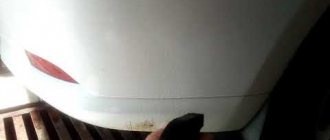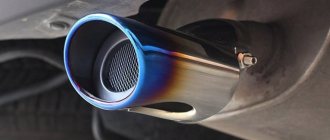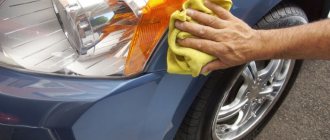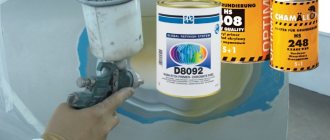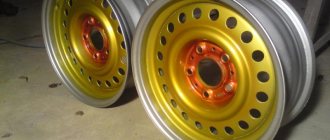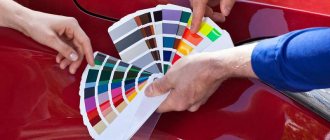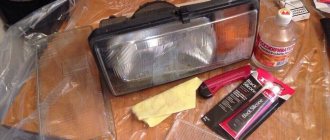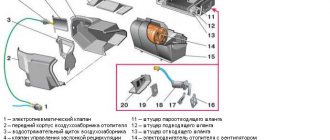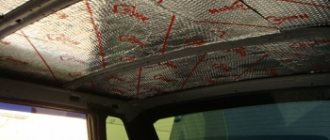Almost any car paint consists of:
- binder - a very important element that helps keep it on the painted surface. It is thanks to this component that the result is a glossy, even plane.
- pigment - a powdered element of paint, the main purpose of which is to achieve the desired color and tone.
- a solvent that gives the paint a level of viscosity suitable for its uniform application. By the way, during operation the solvent evaporates, leaving only the pigment and binder.
The reliability of the protective properties of the coating mainly depends on the density, elasticity, hardness and other physical properties of the paint. For example, using car paint with high hardness levels, you can protect your iron friend from possible scratches or chips. There is a certain combination of these parameters: high hardness values lead to an increase in density values and a decrease in elasticity.
How to dilute paint for painting a car
The ingredients for different paints will be different:
How to dilute acrylic paints
This paint is two-component with a hardener. To mix it, you need to take 1 liter of paint, half a liter of hardener and 100-150 ml of thinner. Thus, from 1 liter of paint, approximately 1.7 liters of the finished product is obtained;
How to thin metallic paint
Such coatings consist of paint, on top of which a varnish is applied. Without the last component, the paints will quickly fade in the sun and will not look very beautiful.
Thus, the set already consists of 5 parts: 1 liter paint, 500-700 ml paint thinner, 1 liter transparent varnish, 500 ml hardener and 100-150 ml varnish thinner. From this list you can see that only thinner is added to the paint, but three components are added to the varnish.
Properties
Metallic differs from regular paint by the presence of aluminum powder in its composition. In general, it is an auto enamel containing a binder, pigment, solvent and small metal particles. The presence of such components allows not only to give the necessary shade to the structure, but also creates the effect of metal shimmering in the sun. However, getting the right results is quite difficult. It is necessary to apply the paint in an even layer, otherwise stains and smudges will appear during operation.
Metallic paint is less susceptible to corrosion than other materials. Over time, the composition does not lose its performance properties and is not exposed to external factors. True, violation of the integrity of the coating leads to gradual destruction of the material.
Due to the high thermal conductivity of the metal contained in the composition, the paint does not overheat when exposed to sunlight and does not fade. The cost of such paint is higher than that of simple enamels, however, it is worth the money spent.
Container for paint thinning
When mixing paints, everything is important, even the container in which it will be mixed. To do this, it is recommended to take a strictly cylindrical jar so that the bottom and walls are even.
It is in such a container that the paint will mix more evenly and an equal amount of added components will be visible. It is best if it is a measuring container with volume marks marked on the walls. It is thanks to them that the components of the paint can be mixed in certain proportions.
Stores also sell rulers with marks on them. Using these marks, the volume fractions of each component can be determined. After adding all the ingredients, it will be convenient to mix them with the same ruler.
Paint dilution proportions
The stores offer paints and varnishes from various manufacturers, and universal proportions do not exist in nature. Each paint manufacturer can indicate in what proportions their paint is mixed.
Although there are no universal recipes, recommended compositions still exist. As it was said, for two-component mixtures you need to add 50% hardener and 10-20% thinner to the base. For one-component formulations, dilute to 50-80%. More precise proportions are indicated on the manufacturer's container.
If the paint is selected through selection, in this case, the complete required set is issued. It just needs to be mixed correctly (all components are already hung in the right proportions). For one-component formulations, they will most likely give you a ready-made, properly mixed product.
It is also worth considering the lifespan of the finished paint and varnish material. They all have their own expiration date. If this indicator is neglected, then the viscosity may change. Therefore, two-component formulations are not mixed in the store when sold.
Types of solvents
Any automotive enamel is sold in liquid form, but this does not mean that it can be used immediately. The manufacturer has already added a solvent to the paint, but just enough so that the composition does not dry out. To obtain an even coating, the material should be diluted additionally. This coating will protect the body from damage and corrosion.
Before mixing paint with solvent, you need to remember that the manufacturer has already added a certain amount. Depending on this, coloring compositions are divided into:
- highly filled;
- medium filled;
- low-filled.
Fullness is a property that determines the volatility and viscosity of the enamel; it helps to understand how much more solvent can be added.
By evaporation rate
Solvents, just like paints, come in different forms; let’s look at their main types. Depending on the evaporation rate, the following compositions are distinguished:
- Slow - they are used for work in the summer or at high temperatures.
- Fast - the components in the composition speed up the drying process and make it possible to work with the material even in winter.
- Universal - allowed for use at average temperature conditions.
According to physical and chemical indicators
Depending on the physical and chemical characteristics, two groups of solvents are distinguished:
- Polar - alcohol, ketones, substances with hydroxyl group molecules. These materials are suitable for working with acrylic paints.
- Non-polar - white spirit, kerosene, a complex of hydrocarbon-based compounds.
In order to accurately determine how to dilute a particular paint, you should find out what solvent the manufacturer used. Match polar to polar or non-polar to non-polar.
Why measure paint viscosity?
Viscosity is a value that shows the fluidity of a liquid. When composing paint, this parameter is very important, because the uniformity of application of the material to the surface, as well as the thickness of the coating, depends on it. After painting, the reliability and beauty of the coating also depends on the initial viscosity of the paint.
The reasons for measuring viscosity can be explained with an example. If you take the treated surface before applying primer, you can see that it consists of depressions and hills. The difference between them can be up to 50 microns.
If a composition that is too liquid is applied to such a surface, then the created film will not cover all surface irregularities. And after processing it will remain uneven. You can, of course, apply additional layers, but this will take much more time.
On the other hand, it would seem that in the opposite situation such problems could be avoided, but this is far from the truth. A liquid that is too thick is not able to fill all the recesses, since the thickness does not allow this to be done because its ability to penetrate is too small. As a result, air deposits form between the paint and the surface, which will cause the paint to come off in the future. Also, a filler that is too thick will not be able to spread into a smooth film, as a result of which processing will take a long time.
If we move from primer to paint and varnish, here are the parameters on which the viscosity of the material depends. So this is the degree of gloss, shade, texture, adhesion and so on.
Some people make the paint a little thinner so that all the cavities are filled, and the thickness can be increased by applying additional layers. But this is not the best solution. The solvent will evaporate for a very long time.
If paint is applied to such a primer, it will not have the necessary adhesion and will come off over time. In addition, the possibility of such an effect as boiling and other unpleasant moments increases.
Composition of car paints
All automotive paints and enamels contain three basic components:
- pigment is a powder substance that gives paint the required color;
- binder base - it holds the pigment and ensures adhesion of the material to the surface;
- solvent - with its help the composition is given the necessary consistency.
Different types of dyes have different physical characteristics - elasticity, density, degree of fullness, and hardness of the layer after drying.
How is paint viscosity measured?
Usually the viscosity of the paint and varnish material is measured by the painter “by eye”. Any object is taken, dipped into the composition and the viscosity is determined. The painter determines, based on parameters known only to him, the degree of viscosity and properties of the resulting liquid. Of course, if the painter has extensive experience in mixing paints, then you can trust him, but what if a beginner needs to mix the correct proportions and determine the desired degree of viscosity?
It has been known since school that the viscosity of any liquid is not so easy to measure, but requires instruments and calculations. At home, such an opportunity will not be available, and it will be painfully difficult for an ordinary repairman. Because of this, the “conditional viscosity” parameter was introduced. To determine it, you need to measure the time during which 100 ml of liquid passes through the hole (usually a 4 mm hole is taken).
Therefore, on the banks you can see the inscriptions 22-24 s. This is the conditional viscosity parameter. This means that 100 ml of diluted paint should pass through the hole in 22 - 24 seconds. This can be measured using a viscometer device. The device itself is a container with a volume of 100 cubic centimeters, but instead of a bottom, such a container has a funnel.
The most common viscometer is DIN4, according to our standards VZ-4. These viscometers have a hole diameter of 4 mm. Also, a device with a VZ-246 funnel can be used for measurement; its nozzles will be removable, each will have a diameter of 2, 4 or 6 mm.
Each manufacturer can use their own viscometer. So for example, the company uses a Ford #4 device, and its nozzle diameter will be one-sixth of an inch, which corresponds to our 4.2 mm. Despite this, the data will not change the fact much. After all, various tables have already been created to recalculate these indicators and they can be easily converted into each other.
Content
However, even if a thinner is not included, the packaging must indicate which one is suitable for this particular paint and its recommended amount. Don’t neglect these instructions: there are many manufacturers, car enamels have different compositions, and if you don’t want to ruin the body of your car or spend money on repainting it, you should read what the manufacturers wrote on the can.
How to dilute car paint and how much to pour such liquid also very much depends on the ambient temperature. So before buying a solvent, it is worth assessing all the conditions in which you are going to paint.
How is paint viscosity measured?
To measure viscosity with a viscometer you need:
- hang the device strictly vertically;
- plug the bottom hole;
- pour in the prepared liquid and let it sit until all the air bubbles come out of the paint;
- the resulting foam can be removed with a knife or any other stick;
- it is necessary to open the hole and at the same time turn on the stopwatch;
- The stopwatch turns off when the paint stops flowing in a full stream and begins to drip.
Ideal measurements are carried out at a temperature of plus 20 degrees. If you neglect the temperature parameter, the readings may be incorrect. So, as the temperature increases, the liquid becomes more fluid, and as the temperature decreases, it becomes tighter.
It is also worth considering that thinners are available for low temperature conditions (they will be faster), for elevated temperatures (slower) and for standard temperatures.
Filtration of paint after dilution
After preparing the paint material and measuring its viscosity, it must also be filtered. Because all the same, during cooking, some specks may get in or there will be clumps of paint. To prevent all this debris from getting onto the parts of the body to be painted, you need to pass the liquid through a filter.
To filter paint and varnish material, you need to take a paper funnel with a nylon filter installed at the bottom (the cell size should be 190 microns). This funnel can be inserted directly into the spray gun tank and pass the desired liquid through it. The paint is refilled - you can use it.
